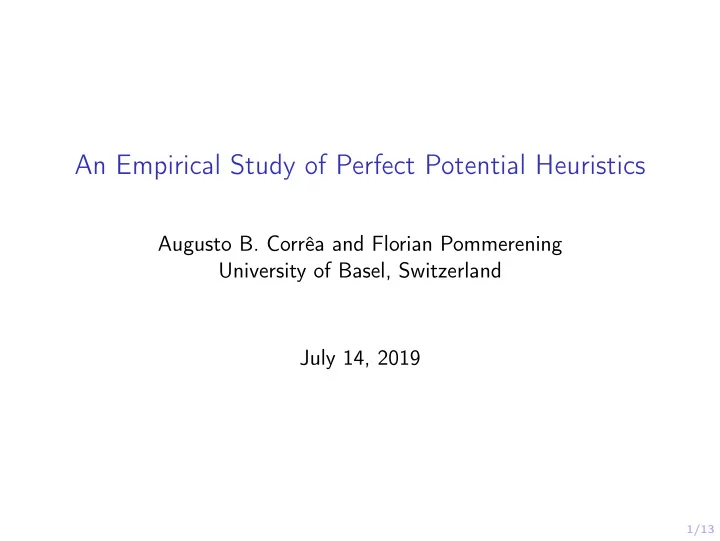

An Empirical Study of Perfect Potential Heuristics Augusto B. Corrêa and Florian Pommerening University of Basel, Switzerland July 14, 2019 1/13
Motivation Context: ◮ Optimal classical planning Goals: ◮ Learn more about the topology of different domains ◮ Study the characteristics of h ∗ ◮ Understand the limitations of potential heuristics 2/13
Potential Heuristics ◮ States are represented as sets of facts ◮ A feature f is a set of facts and it has size | f | ◮ A feature f is true in a state s if f ⊆ s Definition (Potential Heuristic) A weight function w associates a set of features F with weights. It induces a potential heuristic � h pot w ( s ) = w ( f )[ f ⊆ s ] . f ∈F The dimension of h pot is the size of its largest feature f . w ◮ Higher dimension = more complex interactions between facts 3/13
Potential Heuristics What if state s is unsolvable? Then h pot w ( s ) should be ∞ . � if h pot ∞ w 2 ( s ) > 0 h w 1 , w 2 ( s ) = h pot w 1 ( s ) otherwise. h w 1 , w 2 is a perfect potential heuristic if ◮ h pot w 1 ( s ) is perfect for all solvable states s ◮ h pot w 2 captures all unsolvable states correctly 4/13
Optimal Correlation Complexity Definition (Optimal Correlation Complexity of a task) The optimal correlation complexity of a planning task Π is the minimum dimension of a perfect potential heuristic for Π . This gives us some insight about the complexity of the interactions between facts of the task. 5/13
Optimal Correlation Complexity We study optimal correlation complexity of IPC domains empirically Computing optimal correlation complexity is hard We need... ◮ ... h ∗ for all (reachable) state space ◮ ...to find a good set of features ◮ ...to efficiently find a weight function 6/13
Computing a Perfect Potential Heuristic Exact methods for finite and infinite values: ◮ Linear programs over the entire state space ◮ Initial set of candidate features F ; augment it as needed ◮ Potential heuristics found has optimal dimension 7/13
Experiments Using Fast Downward and IPC domains ◮ 30 minutes and 3 . 5 GB per task ◮ 301 tasks over 38 domains where we can compute the perfect heuristic for the entire state space ◮ Sample size is considerably small 8/13
Results Histogram of optimal correlation complexities 30 25 Number of instances 20 15 10 5 0 2 3 4 5 6 7 8 Optimal Correlation Complexity 9/13
Results Lower bounds for the optimal correlation complexity per domain Domain Lower Bound 7 gripper 6 hiking-opt14 7 miconic 2 movie 5 nomystery-opt11 6 organic-synthesis-opt18 8 psr-small 8 rovers 5 scanalyzer-08 5 scanalyzer-opt11 5 storage 5 tpp 6 transport-opt08 8 vistall-opt11 4 zenotravel 10/13
Results Lower bounds for the optimal correlation complexity per domain Domain Lower Bound 7 → 5 gripper 6 hiking-opt14 7 → 6 miconic 2 movie 5 → 4 nomystery-opt11 6 → 1 organic-synthesis-opt18 8 → 4 psr-small 8 → 5 rovers 5 scanalyzer-08 5 scanalyzer-opt11 5 → 4 storage 5 → 4 tpp 6 → 4 transport-opt08 8 → 7 vistall-opt11 4 zenotravel Significant lower complexity considering only reachable states 10/13
Results Lower bounds for the optimal correlation complexity per domain Domain Lower Bound 7 → 5 gripper 6 hiking-opt14 7 → 6 miconic 2 movie 5 → 4 nomystery-opt11 6 → 1 organic-synthesis-opt18 8 → 4 psr-small 8 → 5 rovers 5 scanalyzer-08 5 scanalyzer-opt11 5 → 4 storage 5 → 4 tpp 6 → 4 transport-opt08 8 → 7 vistall-opt11 4 zenotravel Significant lower complexity considering only reachable states Also to detect unsolvable states ◮ Maximum dimension needed to detect unsolvable states was 3 10/13
Computing a (Quasi-)Perfect Potential Heuristic How close can we get with features of limited size? Minimal Error for Finite Values: ◮ Starts with an “empty” potential heuristic ◮ Iteratively selects feature minimizing the error of the heuristic ◮ Once no feature up to size n reduces the error, add features of size n + 1 to feature pool 11/13
Results Remaining error per feature added. (One line per instance.) 10 5 10 4 Error 10 3 10 2 10 1 10 0 10 1 10 2 10 3 10 4 # of features selected 12/13
Results Remaining error per feature added. (One line per instance.) 10 5 10 4 Error 10 3 10 2 10 1 10 0 10 1 10 2 10 3 10 4 # of features selected Only a few features of a given size are very important 12/13
Conclusion Recap ◮ We investigated the “shape” of h ∗ in several domains ◮ Bad news: Even easy domains need perfect potential heuristics with high dimension ◮ Good news: Only a small number of large features already reduce the heuristic error significantly Open Question ◮ How to automatically identify an informative subset of high-dimensional features? ◮ We could find good weights using an FPT algorithm 13/13
Conclusion Recap ◮ We investigated the “shape” of h ∗ in several domains ◮ Bad news: Even easy domains need perfect potential heuristics with high dimension ◮ Good news: Only a small number of large features already reduce the heuristic error significantly Open Question ◮ How to automatically identify an informative subset of high-dimensional features? ◮ We could find good weights using an FPT algorithm 13/13
Recommend
More recommend